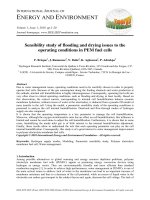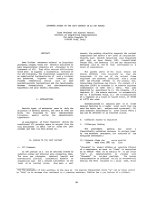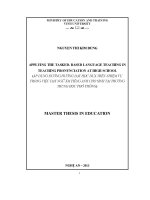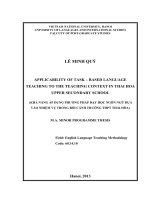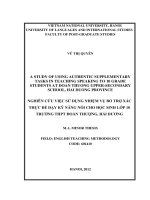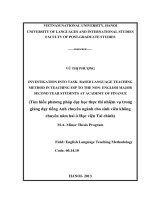Applicability of tasked based language teaching to the teaching context in thai hoa upper secondary school
Bạn đang xem bản rút gọn của tài liệu. Xem và tải ngay bản đầy đủ của tài liệu tại đây (616.34 KB, 170 trang )
VIETNAM NATIONAL UNIVERSITY, HANOI UNIVERSITY OF LANGUAGES
AND INTERNATIONAL STUDIES FALCUTY OF POST-GRADUATE STUDIES
LÊ MINH QUÝ
APPLICABILITY OF TASK – BASED LANGUAGE
TEACHING TO THE TEACHING CONTEXT IN THAI HOA
UPPER SECONDARY SCHOOL
(KHẢ NĂNG ÁP DỤNG PHƯƠNG PHÁP DẠY HỌC NGÔN NGỮ DỰA
VÀO NHIỆM VỤ TRONG BỐI CẢNH TRƯỜNG THPT THÁI HÒA)
M.A. MINOR PROGRAMME THESIS
Field: English Language Teaching Methodology
Code: 60.14.10
Hanoi, 2013
VIETNAM NATIONAL UNIVERSITY, HANOI UNIVERSITY OF LANGUAGES
AND INTERNATIONAL STUDIES FALCUTY OF POST-GRADUATE STUDIES
LÊ MINH QUÝ
APPLICABILITY OF TASK – BASED LANGUAGE
TEACHING TO THE TEACHING CONTEXT IN THAI HOA
UPPER SECONDARY SCHOOL
(KHẢ NĂNG ÁP DỤNG PHƯƠNG PHÁP DẠY HỌC NGÔN NGỮ DỰA
VÀO NHIỆM VỤ TRONG BỐI CẢNH TRƯỜNG THPT THÁI HÒA)
M.A. MINOR PROGRAMME THESIS
Field: English Language Teaching Methodology
Code: 60.14.10
Supervisor: Nguyễn Việt Hùng, MA
Hanoi , 2013
i
CANDIDATE’S STATEMENT
I certificate that the minor thesis entitled “Applicability of task-based language teaching to
the teaching context in Thai Hoa secondary school” is submitted in fulfillment of the
requirements for the degree of Master of Arts is the result of my own work. This minor
thesis or any part of this one has not been submitted for a higher degree to any other
university or institution.
th
Hanoi, 28 June, 2013
ii
ACKNOWLEDGEMENTS
First and foremost, I am most grateful to my supervisor, Mr. Nguyen Viet Hung.
MA for his continual support, encouragement, guidance and ideas. Without his tireless
support, this thesis could not have been completed.
Secondly, I would like to express my great gratitude to all the teachers and
students at Thai Hoa secondary school for their participation and cooperation during the
data collection process.
Thirdly, it is my pleasure to acknowledge my friends, especially Bui Van Hau, ,
from whom I have received a lot of help, support and encouragement.
Finally, my sincere thanks go to my family whose support has been of great
significance to the success of my thesis.
iii
ABSTRACT
Recently task-based language teaching (TBLT) evolving from communicative
language instruction has drawn the attention of many researchers towards itself. To date,
there have not had many studies on applicability of TBLT in a particular context. This
study has intended to explore the attitudes of students‟ towards TBLT. It also seeks the
understanding of teachers‟ of TBLT. A sample of five teachers and three hundred students
participated in this study. A questionnaire was used to examine students‟ attitudes towards
the friendliness of theoretical issues of TBLT. Then, interviews and observations are
employed to find out how teachers understand and implement task-based language learning
in their classroom. The data were analyzed both quantitatively and qualitatively. The results
of the study showed that while students in general had positive attitudes towards TBLT,
teachers lacked conceptualizations of TBLT and their teaching practice did not match
TBLT model. Therefore, these findings led to the conclusion that it is impossible to apply
TBLT to the teaching context in THSS successfully. Finally, suggestions were made in
order to solve those problems mentioned above: teachers should attend seminars on ELT;
they should train themselves through books and articles; there should have had
competitions for both teachers and students to enhance teaching and learning English.
iv
LIST OF APPENDICES
A.
QUESTIONNAIRES FOR STUDENTS
B.
INTERVIEW QUESTIONS FOR TEACHERS
C.
OBSERVATION SHEETS
D.
QUANTITATIVE STATISTICAL DATA
E.
INTERVIEW DATA
v
Tables
Table 1.
Table 2.
Table 3.
Table 4.
Table 5.
Table 6.
Table 7.
Table 8.
Table 9.
Table 10.
Table 11.
Table 12.
Table 13.
Table 14.
Table 15.
Table 16.
Table 17.
Table 18.
Table 19.
Table 20.
Table 21.
Table 22.
Table 23.
Table 24.
Table 25.
vi
Table 26.
Table 27.
Table 28.
Table 29.
Table 30.
Table 31.
Table 32.
FIGURES
Figure 1.
Figure 2.
vii
THSS
Thai Hoa Sec
TBL
Task-Based L
TBLT
Task-Based L
MOET
Ministry of E
CLT
Communicati
TEFL
Teaching Eng
FL
Foreign Lang
L2
Second Langu
DT
Definition of
ET
Examples of T
TBLTM
Task - Based
TGTBLT
Teaching Gra
TBLT vs
OTM
Task – Based
T
Teachers
S
Students
LC
F
LE
Local Culture
Facilities
Local Econom
viii
TABLE OF CONTENT
CANDIDATE’S STATEMENTS……………………………………………..
ACKNOWLEDGEMENTS……………………………………………………
ABSTRACT…………………………………………………………………….
TABLE OF CONTENTS………………………………………………………
LIST OF APPENDICES………………………………………………………
LIST OF TABLES…………………………………………………………….
LIST OF FIGURES……………………………………………………………
LIST OF ABBREVIATIONS …………………………………………………
PART A. INTRODUCTION…………………………………………………..
1.1.
Rationale…………………………………………………………………
1.2.
Aim and objectives of the study…………………………………………
1.3.
Research questions………………………………………………………
1.4.
Scope of the study…………………………………………………………
1.5.
Significance of the study…………………………………………………
1.6.
Method of the study………………………………………………………
1.7.
Design of the study………………………………………………………
PART B. DEVELOPMENT……………………………………………………
Chapter 1. LITERATURE REVIEW………………………………………….
1.1.
Theoretical background of TBLT……………………………………
1.1.1. The learning theory………………………………………………
1.1.2. Input and learning interactionist theory…………………………
1.1.3. Communicative language teaching………………………………
1.1.4. Research on communicative tasks………………………………
1.2.
Task-based language teaching………………………………………
1.2.1 Definition of a task………………………………………………
1.2.2. Task types………………………………………………………
1.2.3. Teacher‟s roles in TBLT…………………………………………
1.2.4. Some problems in implementing TBLT in Asian context………
1.3.
Theoretical framework ………………………………………………
ix
1.3.1. Working terminology……………………………………………
1.3.2. Principles of TBLT………………………………………………
1.3.3. Features of TBLT………………………………………………
1.3.4. Stages of TBLT…………………………………………………
1.3.5. Techniques of TBLT……………………………………………
1.4.
Summary………………………………………………………………
Chapter 2. METHODOLOGY………………………………………………....
2.1.
The fitness of research method…………………………………………
2.2.
Context of the study………………………………………………………
2.2.1. The setting of the study…………………………………………
2.2.2. Informants ………………………………………………………
2.2.2.1. The teachers……………………………………………
2.2.2.2. The students……………………………………………
2.3.
Data collection instruments………………………………………………
2.3.1. Questionnaires……………………………………………………
2.3.2. Interviews………………………………………………………
2.3.3. Class observations………………………………………………
2.4.
Data collection procedure………………………………………………
2.4.1. Interviews………………………………………………………
2.4.2. Questionnaires……………………………………………………
2.4.3. Classroom observations…………………………………………
2.5.
Data analysis………………………………………………………………
2.6.
Reliability and validity of the research…………………………………
Chapter 3. DISCUSSION OF THE FINDINGS………………………………..
3.1 Students’ attitudes towards theoretical issues of TBLT……………………
3.1.1. Students‟ attitudes towards TBLT………………………………
3.1.2. Students‟ attitudes towards each domain of TBLT………………
3.1.3. Difference of Students‟ attitudes towards theoretical issues of T
groups
3.1.4. Main factors which affect students‟ attitudes towards TBLT……
3.2. Findings from semi-structured interviews and classroom observations
x
3.2.1. Teachers‟ conceptualizations of task-based language teaching
3.2.2. Advantages and disadvantages of TBLT…………………………….
3.2.3. Factors affecting the TBLT implementation………………………...
3.2.4. Teachers‟ practice in language classrooms……………………...
3.3 Matches and Mismatches……………………………………………………..
PART C: CONCLUSION………………………………………………………...
1.1. Summary of the major points of the study …………………………………
1.2 Pedagogical implications……………………………………………………..
1.3. Limitations and suggestions for further research………………………….
REFERENCES……………………………………………………………………
APPENDICES…………………………………………………………………….
xi
1
Part A: INTRODUCTION
1.1. Rationale
Task-based teaching is an Anglo-American invention (Ellis, 2003) designed mainly
for adult intermediate learners. It opens new potential orientations and hopes to the EFL
learners and teachers in some aspects of learning and teaching. The task-based language
syllabus, unlike other linguistic and structural syllabuses, takes learners‟ needs into
account. Bygate (1999) indicates how one can use tasks systematically as a context to
develop learners‟ knowledge about language, their ability to use it, and the teachers‟
ability to teach it. He asserts that tasks are needed to improve learners‟ fluency, accuracy,
and complexity in communication. Due to many benefits of TBLT, the set of textbooks for
secondary schools was passed by MOET in 2006 in which communicative learner-centred
approaches and task-based language teaching are adopted. Students can participate in
activities through individual, pair, and group work, and they can interact with each other
„actively, creatively and cooperatively‟ (Van et al, 2006, p.10). Along the line with the
innovative trend, departments of education and training in provinces and cities have
declared that lower and upper secondary schools need follow the communicative approach
and TBLT suggested by authors of textbooks and MOET. In order to put this policy into
pratice, it is necessary to have many researches about the applicability of TBLT in different
contexts. Thus, the question “Is Task-based Language Teaching (TBLT) applicable the
teaching context in Thai Hoa secondary school?” is worth being investigated before any
decisions of TBLT implementation.
The applicability of a teaching method into a specific teaching context is feasible in
case three major factors are met: (1) There exist the textbooks or teaching materials
friendly to that teaching method; (2) students have positive attitudes towards features of
that method; and (3) teachers are aware of that teaching method. The first factor is met
because the textbooks of English for secondary schools are declared to adopt TBLT (Van,
2011, pp.96-106; Hung, 2011, pp.124-131).
Therefore, in order to decide whether the two other factors are met or not, the
research has to investigate students‟ attitudes towards theoretical issues of TBLT and the
teachers‟ perception of TBLT in Thai Hoa Secondary school.
1.2. Aim and Objectives of the study
The main aim of the study is to find out how applicable task-based language
learning (TBLL) is in the teaching context of Thai Hoa Secondary School (THSS); this aim
is subdivided into following objectives to be easier to manage:
2
To get investigate students‟ attitudes towards the friendliness of theoretical issues
of TBLT by a survey questionnaire.
To find out how teachers understand and implement task-based language learning
in their classroom by case studies in which interviews and observations are employed.
1.3. Research questions
In order to meet the objective of the study, the following research questions are raised:
1.
What are students‟ attitudes towards theoretical issues of task-based
language
learning?
2.
What are teachers‟ perceptions of task-based language learning?
1.4. Scope of the study
In order to find out the applicability of TBLT in the teaching context of Thai Hoa
secondary school, the study is only focused the attitudes of students‟ towards TBLT and
the understanding of teachers‟ of TBLT. In addition, the study is only carried out in THSS.
1.5. Significance of the study
The findings of the research will help teachers have a more comprehensible
understanding of students‟ attitudes and teacher‟s perceptions towards TBLT. Also, they
will know benefits of TBLT but challenges facing them and their students when
implementing TBLT. Finally, some suggestions will be made in order to help them apply
TBLT at THSS successfully.
1.6. Method of the study
To achieve the aims of the study, both quantitative and qualitative methods are
employed and the following steps are involved:
Collecting data by survey questionnaires for students
Conducting an interview and a class observation with teachers for further
information of the study
All comments, remarks, recommendations and conclusion are based on the data
analysis. This data hoped to confirm and support the results obtained from other sources.
1.7. Design of the study
This study is organized into three main parts as follows:
Part A: Introduction
This part presents the rationale, the aims and objectives, research questions, scope,
significance, method, and design of the study.
Part B: Development
This part is divided into 3 chapters.
3
Chapter 1 Literature review: it serves as the theoretical background for the study,
presenting the concepts and relevant theories.
Chapter 2 Methodology: it discusses the context of the study, the data collection
instruments, the data collection procedure, and the data analysis.
Chapter 3 – Results and Discussion: it presents significant findings of the study, a
discussion of the major findings.
Part C: Conclusion
It summarizes the main issues addressed in the study, discusses limitations and some
pedagogical implications. In addition, it also offers suggestions for further researches.
4
Part B: DEVELOPMENT
Chapter 1. LITERATURE REVIEW
1.1. Theoretical Background of TBLT
The first person who has applied TBLT to teaching programs and practice is
Prabhu. It was in Bangalore of southern Indian in 1979 that Prabhu began his bold
experiments to put his theories into practice which seemed radical at that time. According
to Prabhu, students may learn more effectively when their minds are focused on the task,
rather than on the language they are using (Prabhu, 1987). Therefore, Prabhu is thought to
be the originator of TBLT.
The theoretical basis of TBLT dates back to cognitive psychology „the Learning
theory‟ that has deeply affected the elementary education. Allwright (1977) put that “If the
language activities involve the learners in solving communicative problems in the target
language, language learning will take care of itself”. Also, the other theoretical foundations
of TBLT are Krashen‟s “Input and Interactionist Theory” and “Communicative Language
Teaching”.
1.1.1. The Learning Theory
In task-based language teaching, syllabus content and instructional processes are
selected with reference to the communicative tasks which learners will (either actually or
potentially) need to engage in outside the classroom and also with reference to theoretical
and empirical insights into those social and psycholinguistic (cognitive) processes which
facilitate language acquisition. This approach to language teaching commonly includes the
ideas of learning theories of Piaget‟s cognitive theory and Vygotsky‟s social constructivist
theory.
“Piaget described overall development as the result of children‟s interaction with
their environment, with a complementary interaction between their developing perceptual
cognitive capacities and their linguistic experience” (Brown 2002, p.29).
Piaget emphasized the constructive nature of the learning processes. That is,
individuals are actively involved right from birth in constructing personal meaning, which
is their personal understanding from their experiences.
Vygotsky (1987) claims that cognitive development and learning originates in a
social context. Vygotsky believed that higher psychological functions, such as learning,
develop in interaction between individuals. He hypothesized the existence of a Zone of
Proximal Development (ZPD), where functions learnt in a social dimension are transferred
to a cognitive dimension. An implication of this theory is that a learner learns under the
5
guidance of an expert, who provides assistance and support by adjusting the difficulty of
the task. Since a language classroom can also be considered as a social environment, the
phenomena of interaction which take place there can be analyzed in the light of this theory.
Vygotsky‟s the “zone of proximal development” is probably his best-known concept. It
argues that students can, with the help from adults or children who are more advanced,
master concepts and ideas that they cannot understand on their own. No one ever achieves
the full extent of their learning potential, but people can continue to develop their cognitive
capacity throughout their lives and their social interaction.
Vygotsky (1978) shared many of Piaget‟s assumptions about how children learn,
but he placed more emphasis on the social context of learning. Piaget‟s cognitive theories
have been used as the foundation for the discovery of learning models in which the teacher
plays a limited role. In Vygotsky‟s theories both teachers and older or more experienced
children play very important roles in learning. There is a great deal of overlap between
cognitive constructivism and Vygotsky‟s social constructivist theory. However, Vygotsky‟s
constructivist theory, which is often called social constructivism, has much more room for
an active involved teacher. For Vygotsky, the culture gives the child the cognitive tools
(they are features of our minds that shape the ways we make sense of the world around us;
the richer the cognitive toolkit we accumulate, the better the sense we make.) needed for
his development. The type and quality of those tools determine, to a much greater extent
than they do in Piaget‟s theory, the pattern and rate of development. Adults such as parents
and teachers are conduits for the tools of the culture, including language. The tools of the
culture provides to a child include cultural history, social context, and language. Today
they also include electronic forms of information access.
Supported by social-interactive and constructive theory, a social constructive model
of the teaching-learning process comes into being. It emphasizes the dynamic nature of the
interplay between teachers, learners and tasks, and provides a view of learning as arising
from interactions with others. In this model, a learner is an active meaning-maker and
problem-solver and tasks involve input in the form of a piece of text or language. They
involve activities, which are what the learners are required to do; and they involve
cognitive operations, which are the cognitive process needed in order to carry out the
activities. Together with the other two key factors, teachers and context, they interact as
part of a dynamic, ongoing process.
1.1.2. Input and Interactionist Theory
6
Rod Ellis thought that the theoretical base of task-based approach is Input and
Interactionist Theory (Ellis, 1999). The explanation of Input and Interactionist Theory
which Krashen emphasizes refer to using language to learn and then learning to use
language. Krashen and other second language acquisition theorists typically stress that
language learning comes about through using language communicatively, rather than
through practicing language skills. That is to say, we acquire a language mostly is the result
of using language in the process of communicative activities, not the result of conscious
language drilling.
According to Krashen (1982), we acquire a language through our subconscious
acquisition process not our conscious learning process. Language acquisition is a
subconscious process not unlike the way a child learns language. Language acquirers are
not consciously aware of the grammatical rules of the language, but rather develop a “feel”
for correctness. In non-technical language, acquisition is “picking-up” a language.
Language learning, on the other hand, refers to the conscious knowledge of a foreign
language, knowing the rules, being aware of them, and being able to talk about them. Thus
language learning can be compared to learning about a language.
Krashen also points out the students to acquire a language must receive
comprehensible input. The input hypothesis states that a language acquirer who is at level
“i” must receive comprehensible input that is at level “i+1”. We acquire, in other words,
only when we understand language that contains structures that is „a little beyond‟ where
we are now. This understanding is possible due to using the cultural background of the
language we are hearing or reading and our knowledge of the world. Interactionist critics
pointed to some insufficiencies of Krashen‟s comprehensible input theory (Long, 1985).
They doubted that mere exposure to input, even if comprehensible, could promote
language learning. When reading a book, watching a TV program, or listening to a radio
broadcast learners do not interact with the source of language: the communication is
unidirectional. They do not have the opportunity to show that they have not understood the
message, to ask for clarifications or repetitions. On the basis of these considerations Long,
although accepting the comprehensible input theory, decided to study how input is made
comprehensible. His researches showed that native speakers consistently modify their
speech when they interact with non-native speakers.
Most native speakers seem to adjust naturally their speech to the non-nativespeakers needs, in order to facilitate communication (Long, 1983). Long (1983, pp.177193) suggests that language acquisition can be gained only through the „conversational
7
interaction‟. Meanwhile, he also thinks that the necessary language acquisition device is
“modified interaction” , which concerns (l) the modified interaction may make the input
comprehensible; (2) the comprehensible input is good for language acquisition; (3)
modified interaction benefits language acquisition.
Therefore, in ELT we should design the activity with the modified interaction (task)
so that learners can naturally acquire language through the conversational interaction.
Task-based language teaching can make language learning in classrooms closer to the
natural route and may reach a higher rate of language acquisition because it provides
learners with a clear communicative goal, interaction is needed to reach the goal, and
comprehensive input can occur, and then language acquisition is facilitated. Nowadays,
more and more designers of communicative syllabuses attempts to organize
communicative language teaching around a specification of communicative tasks. Some
classroom activities are often designed to focus on completing tasks that are mediated
through language or involve interaction or negotiation of information and information
sharing.
1.1.3. Communicative Language Teaching
Task-based language teaching can be regarded as one particular development within
the broader “communicative approach” (Littlewood 2004, p.1). Communicative language
teaching (CLT) has become the accepted orthodoxy theory of Teaching English as a
Foreign Language (TEFL) over the past ten years or more, and many, but not all, general
courses include communicative goals, communicative practice or communicative
methodology. Its theoretical base, according to Richards and Rodgers (2001, p.71),
includes these characteristics:
1.
Language is a system for the expression of meaning.
2.
The primary function of language is for interaction and communication.
3.
The structure of language reflects its functional and communicative uses.
4.
The primary units of language are not merely its grammatical and structural features,
but categories of functional and communicative meaning as exemplified in discourse.
Communicative language teaching makes use of real-life situations that necessitate
communication. The teacher sets up a situation that students are likely to encounter in real
life. Unlike the Audiolingual method of language teaching, which relies on repetition and
drills, the communicative approach can leave students in suspense as to the outcome of a
class exercise, which will vary according to their reactions and responses. The real-life
simulations change from day to day. Students‟ motivation to learn comes from their desire
to communicate in meaningful ways about meaningful topics.
8
Berns, an expert in the field of communicative language teaching, writes in
explaining Firth‟s view that “language is interaction; it is interpersonal activity and has a
clear relationship with society. In this light, language study has to look at the use (function)
of language in context, both its linguistic context (what is uttered before and after a given
piece of discourse) and its social, or situational, context (who is speaking, what their social
roles are, why they have come together to speak) ” (Berns 1984, p.5).
1.1.4. Research on Communicative Tasks
There have been several researches about tasks for over two decades (for example
Shavelson & Stern, 1981; Candlin, 1987; Long, 1989). The researchers try to characterize
elements around tasks.
Shavelson and Stern (1981, p.478) suggests that tasks design should take into
consideration the following elements:
l) Content--the subject matter to be taught
2)
Materials--the things that learners can observe/manipulate
3)
Activities--the things the learners and teacher will be doing during the lesson
4)
Goals--the teacher's general aim for the task (they are much more general and vague
than objectives)
5)
Students--their abilities, needs and interests are important.
6)
Social community--the class as a whole and its sense of “groupness”.
Wright (1987) suggests that tasks minimally contain just two elements: input data
which may be provided by materials, teachers or learners, and an initiating question which
instructs learners on what to do with the data.
Candlin (1987) characterizes that tasks should contain input, roles, settings, actions,
monitoring, outcomes and feedback. Input refers to the data presented for learners to work
on. Roles specify the relationship between participants in a task. Setting refers to the
classroom and out-of-class arrangements entailed in the task. Actions are the procedures
and sub-tasks to be performed by the learners. Monitoring refers to the supervision of the
task in progress. Outcomes are the goals of the task and feedback refers to the evaluation of
the task.
Long (1989) discussed two commonly aspects of communication tasks-the
distribution of task-essential information and the goal orientation of learners. Regarding
information distribution, Long discusses “one-way” tasks in which one learner holds all
task- essential information and must communicate it to the others, and “two-way” tasks in
which task-essential information is distributed between learners, enquiring them to share
and integrate it. Regarding goal orientation, Long discusses “open” task in which learners
know that there is no “correct” solution to the task, and “closed” tasks in which learners
9
know that there is only one or a small range of solutions. Pica, Kanagy, and Falodun
(1993) combine these conditions to produce a typology of tasks based on the opportunities
for interaction that they provide.
Yule (1997) provided a second typology of communication tasks. Yule proposes
three task types (descriptive, instructional, and narrative) and argues that the discourse
skills necessary for descriptive task are entailed in instructional task, and that the skills for
both are entailed in narrative tasks. Whereas the typology of Pica et al. (1993) helps to
understand how learners need to interact on individual tasks, Yule‟s (1997) typology
provides a basis for sequencing tasks developmentally. Although new approach is emerging
(Skehan:1998), the typology of Pica et al. (1993) and Yule (1997) provide a basis for
organizing foreign language instruction, and are relatively representative of current
practice.
Lambert (2004) introduced an approach to planning sequences of communication
tasks that require becoming personally involved in their learning. By drawing on their own
ideas and experience, as a product of earlier tasks in a given sequence, learners generate
the content and resource material on which subsequent tasks operate. Lambert‟s idea is
intended to increase understanding of the potential of tasks as a planning tool in FL/L2
education, and to provide practical examples for teachers and materials designers.
1.2. Task-based language teaching
1.2.1. Definition of a task
How to define what a task is, which has attracted a considerable amount of concern
of researchers and educators for decades. It seems that the continuum of definitions of task
is longer and longer. Therefore, the term task has been defined from different perspectives.
In terms of real world task, Long (1985) states that a task is:
A piece of work undertaken for oneself or for others, freely or for some reward. Thus
examples of tasks include painting a fence, dressing a child, filling out a form, buying a
pair of shoes, making an airline reservation, borrowing a library book, taking a driving
test, typing a letter, weighing a patient, sorting letters, talking a hotel reservation,
writing a cheque, finding a street destination and helping someone across a road. In
other words, by „task‟ is meant the hundred and one things people do in everyday life,
at work, at play, and in between (p.89).
The prominent feature of the task in this definition is that a task can be either
linguistic or non linguistic one. When a task is converted from outside world into
classroom, it becomes pedagogical task. Breen (1987, p.23) defines a task is:
Any structured language learning endeavour which has a particular objective,
appropriate content, a specified working procedure, and a range of outcomes for those
who undertake the task. „Task‟ is therefore assumed to refer to a range of workplans
10
which have the overall purposes of facilitating language learning – from the simple and
brief exercise type, to more complex and lengthy activities such as group problemsolving or simulations and decision-making.
This definition is very large, implying as it does, that just about anything the learner
does in the classroom qualifies as a task. It could, in fact, be used to justify any procedure
at all as „task-based‟, and, as such, is not particularly helpful. Also, Nunan (1989, p.10)
argues that a task is “a piece of classroom work which involves learners in comprehending,
producing or interacting in the target language while their attention is principally focused
on meaning rather than form”.
One of the definitions of task advocated much among researchers is Willis‟s
definition (1996) indicates that „tasks are always activities where the target language is
used by the leaner for a communicative purpose (goal) in order to achieve an outcome‟
(p.23). Drawing on Breen‟s (1987) definition, Littlejohn (1998) proposed a broader
definition: „A task refers to any proposal contained within the materials for action to be
undertaken by the learners, which has the direct aim of bringing about the learning of the
foreign language‟ (p. 198).
With this definition, each three aspects of task: process, participation and content
[Process means what teachers and learners go through; classroom participation concerns
whom learners work with in the process. Content is something that learners focus on
(Littlejohn, 1998)].
Skehan (1998) generalizes features of a task as follows:
1) Meaning is primary;
(2)
Learners are not given other people‟s meaning to repeat;
(3)
A task has some connection to the real-world;
(4)
Task completion has some priority;
(5)
The assessment of the task is in terms of outcome (p.95).
Finally, stressing both meaning and form, Ellis (2003), drawing on the research, also
defines task in a pedagogical way:
A work plan that requires learners to process language pragmatically in order to
achieve an outcome that can be evaluated in terms of whether the correct or appropriate
propositional content has been conveyed. To this end, it requires them to give primary
attention to meaning and to make use of their own linguistic resources, although the
design of the task may predispose them to choose particular forms. A task is intended to
result in language use that bears a resemblance direct or indirect to the way language is
used in the real world. Like other language activities, a task can engage productive or
receptive, and oral or written skills and also various cognitive processes (p.16).
11
Ellis‟s (2003) definition is very pedagogical because it includes attention to
meaning and engagement with grammar in addition to other major points in language
teaching, such as inclusion of pragmatic properties, use of authentic language and
cognitive process.
In summary, while these definitions vary somewhat, they all emphasize the fact that
tasks involve communicative language use in which the user‟s attention is focused on
meaning rather than grammatical form. But this does not mean that form is not important”
(Nunan, 2006, p.17). I totally agree with Hung (2012c) defining that a task as:
the basis for teaching and learning, is goal – oriented, meaning – focused first and form
– focused then, and is implemented by students with a clear procedure or mechanism in
combination with enough authentic and comprehensible input. The task doing is
through interactions (in pairs or in small groups) in which their own experiences of
target language are exploited, and lastly access the completeness through the outcome
(p.24).
1.2.2. Task types
In the literature on TBLT, several attempts have been made to group tasks into
categories, as a basis for task design and description. However, for the properness of this
section, only several ones are described. According to Prahu, cited in Nunan (2004, p.56),
identifies three types of task: information gap, reasoning gap, and opinion gap.
+
Information – gap activity, which involves a transfer of given information from
one person to another – or from one form to another, or from one place to another –
generally calling for the decoding or encoding of information from or into language.
+
Reasoning – gap activity, which involves deriving some new information from
given information through processes of inference, deduction, practical reasoning, or a
perception of relationships or patterns.
The activity necessarily involves comprehending and conveying information, as an
information – gap activity, but the information to be conveyed is not identical with that
initially comprehended. There is a piece of reasoning which connects the two.
+
Opinion – gap activity, which involves identifying and articulating a personal
preference, feeling, or attitude in response to a given situation. One example is story
completion; another is taking part in the discussion of a social issue. The activity may
involve using factual information and formulating arguments to justify one‟s opinion, but
there is no objective procedure for demonstrating outcomes as right or wrong, and no
reason to expect the same outcome from different individuals or on different occasions.
Another classification of task types, proposed by Richards, cited in Nunan (2004, p.58),
specifying 5 kinds of task:

